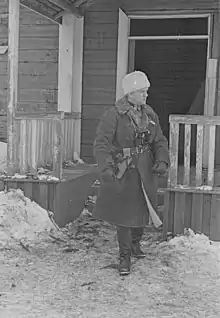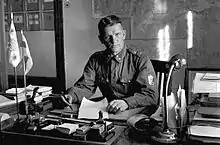Aaro Pajari
Aaro Olavi Pajari (17 July 1897 – 14 October 1949) was a Major General in the Finnish Army. During World War II, he became one of the four double recipients of the Mannerheim Cross 2nd Class.

Aaro Pajari | |
|---|---|
 Aaro Pajari | |
| Born | 17 July 1897 Asikkala, Grand Duchy of Finland, Russian Empire |
| Died | 14 October 1949 (aged 52) Kokkola, Finland |
| Buried | |
| Allegiance | |
| Service/ | Finnish Army |
| Years of service | 1917–1949 |
| Rank | Major General |
| Battles/wars | Finnish Civil War Winter War World War II Continuation War Lapland War |
| Awards | Mannerheim Cross of Liberty (Twice) |
His greatest achievement was the Finnish victory at the Battle of Tolvajärvi in the Winter War, where his small Finnish force smashed a far larger Soviet army. Pajari went on to serve throughout the Winter, Continuation, and Lapland wars, becoming famous for his success in leading small unit, and guerrilla style operations.
Early life
Aaro Pajari was born in 1897 to politician and teacher Olli Pajari and Maria Helena Laatunen. In 1917 he joined the White Guard and participated in the Finnish Civil War as a company commander. Pajari was wounded in the battles of Oulu and Heinola. After the civil war Pajari remained in the military and took part in the Aunus expedition.
In 1928 Pajari married Kaija Björklund.
Second World War
At the start of the Winter War, Lieutenant Colonel Pajari had JR 16 (Jalkaväkirykmentti 16) under his command. Pajari led the first Finnish successful mission in the Winter War by defeating the Soviet Union 139th Division in Battle of Tolvajärvi. He was promoted to colonel on 18 December 1939. In Tolvajärvi, Detachment Pajari was part of Group Talvela. After Talvela moved to the Isthmus, Pajari became the commander of the group.
In the beginning of the Continuation War, Colonel Pajari commanded 18th division, which carried out a breakthrough in August 1941, of which Pajari was appointed on 14 September 1941 as the Knights of the Mannerheim Cross number 12. He was promoted to General Major on 3 October 1941. In 1942 he led the conquest of Suursaari. Pajari was moved to the 3rd The Division commander on 21 October 1943. During Soviet strategic Karelian offensive June 1944 Pajari commanded the 3rd division during major battles at two Finnish defensive lines (VT-asema, VKT-asema).[1]
At the Lapland War General Major Pajari commanded 3rd division during conquest of Tornio (in northern Finland) from Nazi Germany in the beginning of October 1944. For this achievement, he was appointed as the Knights of Mannerheim Cross for the second time (one of the four double knights) on 16th October 1944.[2]
Pajari's Boys
Pajari had achieved a legendary reputation. He was a controversial and colourful personality who was criticized by many colleagues, but he was appreciated by his men. There was an exceptionally strong bond between Pajari and his men. Even during the war, men began to call themselves "the Sons of Pajari".
These sons included Finlayson's social director and member of parliament Eero Kivelä, Tampere Mayor Erkki Lindfors, and a teacher & the chairman of Tampere City Council, Lauri Santamäki. After the wars, Lindfors and Santamäki created the Tampere Arms Shaft, which had a major impact on the development of Tampere.
Death
Pajari suffered from heart ailments and died of a heart attack on a business trip to Ostrobothnia in 1949. He is buried in the Kalevala Cemetery in Tampere. The memorial stone for Pajari, designed by Unto Ojonen, was erected in Asikkala 6 March 1977.
References
- Raunio, A.; Kilin, J. (2013). Jatkosodan torjuntataisteluja 1942-44. Helsinki, Finland: Karttakeskus Oy. pp. 178–193. ISBN 978-951-593-070-5.
- "Mannerheim-ristin ritarien säätiö - Ritarit". www.mannerheim-ristinritarit.fi. Retrieved 29 October 2020.
- Niemi, Leena (2002) "Aaro Olavi Pajari (1897-1949) Vaikuttaja kaupungissa ja sotarintamalla" Koskesta Voimaa approx. translation of title "Aaro Olavi Pajari (1897-1949) in civil and military circumstances", with photo